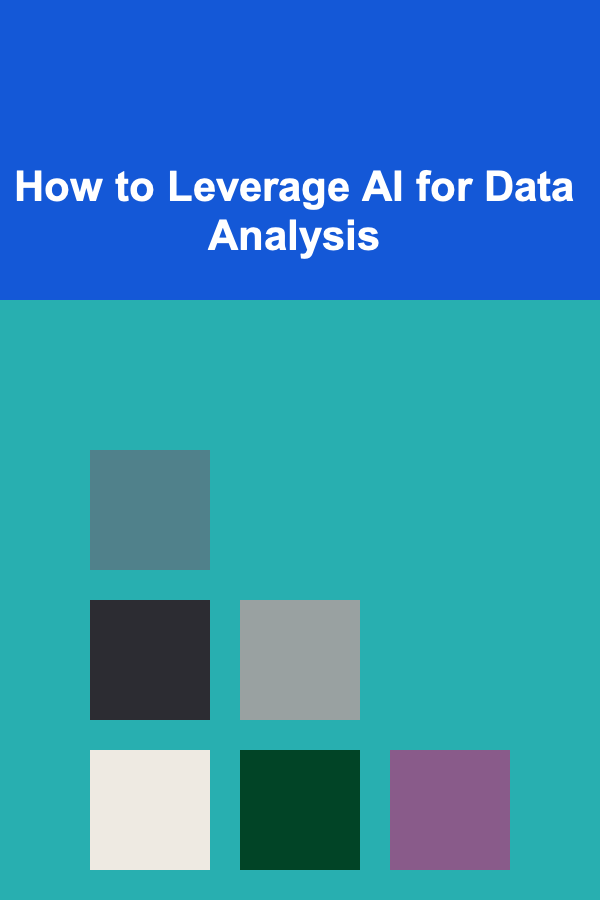
How to Leverage AI for Data Analysis
ebook include PDF & Audio bundle (Micro Guide)
$12.99$8.99
Limited Time Offer! Order within the next:

In the age of digital transformation, the volume, variety, and velocity of data have skyrocketed, creating new opportunities and challenges for organizations across all industries. Data analysis, once a manual and time-consuming process, has evolved with the integration of artificial intelligence (AI), making it faster, more accurate, and more insightful than ever before. But how can organizations leverage AI for data analysis effectively? In this article, we will explore the ways AI can be utilized for data analysis, the tools and technologies available, and how businesses can implement AI to enhance their data-driven decision-making processes.
The Role of AI in Data Analysis
Data analysis involves inspecting, cleaning, transforming, and modeling data with the goal of discovering useful information, drawing conclusions, and supporting decision-making. Traditionally, this process has required skilled data analysts and statisticians to sift through large datasets, applying statistical models and algorithms manually. However, AI can automate many of these steps, allowing organizations to quickly extract valuable insights from vast amounts of data.
AI in data analysis offers several advantages:
- Increased Speed: AI can process large datasets at speeds far beyond human capability. This enables businesses to gain insights in real-time or near-real-time, which is crucial in fast-paced industries like finance, healthcare, and marketing.
- Improved Accuracy: Machine learning (ML) models can uncover patterns in data that are difficult for humans to detect. These patterns can be used to predict outcomes more accurately, whether it's forecasting sales, identifying potential risks, or predicting customer behavior.
- Scalability: AI can handle vast datasets, including unstructured data like images, videos, and social media posts, which would be impossible for traditional analysis methods to process at scale.
- Advanced Analytics: AI-powered tools can perform more advanced analytics like predictive analytics, sentiment analysis, and anomaly detection, providing deeper insights that can drive strategic decisions.
- Automation: AI can automate repetitive tasks such as data cleaning, data integration, and feature selection, allowing data scientists and analysts to focus on more complex tasks.
Types of AI Techniques for Data Analysis
1. Machine Learning (ML)
Machine learning is a subset of AI that involves training algorithms to learn from data and make predictions or decisions without being explicitly programmed. There are various types of machine learning techniques that are widely used in data analysis:
- Supervised Learning: In supervised learning, algorithms are trained on labeled data, which means the input data comes with corresponding output labels. The goal is for the algorithm to learn the relationship between inputs and outputs, so it can predict the output for new, unseen data. Applications of supervised learning in data analysis include regression analysis (predicting continuous values like prices or sales) and classification (assigning labels to data points, such as identifying whether an email is spam).
- Unsupervised Learning: Unsupervised learning algorithms are used to find hidden patterns or groupings in data without prior knowledge of labels. Techniques like clustering and dimensionality reduction fall under this category. For example, clustering can be used to segment customers into different groups based on purchasing behavior, while dimensionality reduction can help reduce the number of features in a dataset, making analysis easier.
- Reinforcement Learning: This type of machine learning involves training models through interactions with their environment. The algorithm takes actions and learns from the feedback or rewards it receives. While less common in traditional data analysis, reinforcement learning is used in areas such as robotics and decision-making processes that require optimization over time.
2. Natural Language Processing (NLP)
Natural language processing (NLP) is a field of AI that focuses on enabling machines to understand, interpret, and generate human language. In data analysis, NLP can be used to extract insights from unstructured text data, such as social media posts, customer reviews, and emails. Some common applications of NLP in data analysis include:
- Sentiment Analysis: Analyzing customer feedback, social media mentions, or product reviews to understand the sentiment (positive, negative, or neutral) expressed by individuals. This can help businesses gauge customer satisfaction and improve products or services.
- Topic Modeling: Identifying themes or topics within a collection of documents. This is useful for organizing and summarizing large amounts of text data, such as customer feedback or market research reports.
- Text Classification: Categorizing text data into predefined categories, such as spam detection in emails or identifying the type of customer service issue from a support ticket.
3. Deep Learning (DL)
Deep learning, a subset of machine learning, uses artificial neural networks to model complex patterns in large datasets. While machine learning algorithms typically use hand-engineered features, deep learning models can automatically learn features directly from raw data. Deep learning excels in tasks such as image recognition, speech recognition, and natural language understanding. In the context of data analysis, deep learning can be used for:
- Image and Video Analysis: Analyzing visual data to identify objects, faces, or anomalies. For example, AI models can automatically analyze medical images to detect signs of disease, or analyze security camera footage to detect suspicious activity.
- Time Series Forecasting: Using deep learning models to predict future values in a time series, such as stock prices or demand for products, based on historical data.
- Anomaly Detection: Deep learning models can be used to detect unusual patterns in data that may indicate fraud, cybersecurity breaches, or system malfunctions.
4. Robotic Process Automation (RPA)
Robotic Process Automation (RPA) refers to the use of software robots or "bots" to automate repetitive, rule-based tasks. In data analysis, RPA can be used to automate the collection, cleaning, and transformation of data from various sources. For example, an RPA bot can automatically scrape data from websites, clean it, and feed it into a database or analysis tool. By automating these mundane tasks, organizations can improve efficiency and reduce human error.
Tools and Platforms for AI-Based Data Analysis
Several AI tools and platforms are available to help organizations harness the power of AI for data analysis. These tools vary in complexity, ranging from simple no-code platforms to advanced machine learning frameworks. Here are some popular AI tools for data analysis:
1. Google Cloud AI Platform
Google Cloud AI offers a suite of machine learning and AI tools that enable organizations to build, deploy, and scale AI models for data analysis. These tools include pre-built machine learning models for common tasks like image recognition and natural language processing, as well as AutoML tools that allow users to train custom models without requiring deep technical expertise.
2. Microsoft Azure Machine Learning
Azure Machine Learning is a cloud-based platform that provides a wide range of tools for building, training, and deploying machine learning models. The platform includes automated machine learning capabilities, as well as pre-built models for tasks such as anomaly detection, predictive analytics, and text analysis.
3. IBM Watson Studio
IBM Watson Studio is an integrated development environment that allows data scientists, application developers, and business analysts to collaborate on AI and data science projects. It provides a range of tools for data preparation, model building, and deployment, as well as pre-built AI models for common use cases.
4. H2O.ai
H2O.ai is an open-source machine learning platform that provides tools for building and deploying machine learning models. It includes AutoML capabilities, which allow users to build models without writing code, and a set of advanced algorithms for tasks such as predictive modeling and anomaly detection.
5. Tableau with AI Integration
Tableau is a popular data visualization tool that has integrated AI features to enhance its data analysis capabilities. Through its integration with AI platforms like Salesforce Einstein, Tableau allows users to apply machine learning models to their data and generate predictive insights directly within the visualization interface.
How to Implement AI for Data Analysis
Implementing AI for data analysis requires a thoughtful approach to ensure that the AI models are integrated into your existing data infrastructure and deliver valuable insights. Here are some steps to follow when implementing AI for data analysis:
1. Define Clear Objectives
Before diving into AI, it's essential to have a clear understanding of the problem you're trying to solve. Are you trying to predict sales, identify fraud, improve customer satisfaction, or optimize supply chains? Having well-defined objectives will help you choose the right AI techniques and tools for the job.
2. Prepare and Clean Your Data
Data preparation is often the most time-consuming step in the data analysis process. AI models require clean, structured, and relevant data to perform well. This means cleaning up missing or inconsistent data, handling outliers, and transforming the data into a format suitable for machine learning algorithms. It is essential to ensure data quality before feeding it into AI models.
3. Choose the Right AI Techniques
Based on your objectives and the type of data you have, select the appropriate AI techniques. For example, if you're dealing with structured data, supervised learning algorithms like regression or classification may be a good fit. If you're analyzing text data, natural language processing techniques may be more appropriate. For unstructured data like images, deep learning models are ideal.
4. Train and Test Your Model
Once you've selected an AI technique, train your model using historical data. This involves feeding the model data and adjusting its parameters until it can make accurate predictions. After training, it's essential to test the model using unseen data to evaluate its performance. If the model's accuracy is not satisfactory, you may need to adjust its parameters or choose a different algorithm.
5. Deploy and Monitor the Model
After training and testing, deploy your model into production. This means integrating it into your existing data systems, so it can start making predictions on live data. Continuous monitoring is critical to ensure the model continues to perform well over time. If the data distribution changes, you may need to retrain the model to maintain its accuracy.
6. Iterate and Improve
AI models are not static; they require continuous improvement. Regularly assess the model's performance and refine it as new data becomes available. The more data you feed into the model, the more accurate and insightful it becomes.
Conclusion
Leveraging AI for data analysis is no longer a luxury---it's a necessity for organizations that want to stay competitive in a data-driven world. By incorporating AI into the data analysis process, businesses can unlock valuable insights, improve decision-making, and gain a deeper understanding of their operations, customers, and markets. From machine learning and natural language processing to deep learning and robotic process automation, AI offers powerful tools to transform how data is analyzed and utilized.
As the field of AI continues to evolve, organizations that embrace these technologies will be better positioned to adapt to changing business environments, stay ahead of competitors, and deliver exceptional value to their customers. The key is to start small, experiment, and gradually integrate AI into your data analysis workflows to see its transformative potential firsthand.
Reading More From Our Other Websites
- [Hiking with Kids Tip 101] Family-Friendly Desert Routes: Where to Go, What to See, and How to Prepare
- [Home Storage Solution 101] How to Optimize Home Storage Solutions for Clothes
- [Personal Finance Management 101] How to Use the Debt Avalanche Method When You Have Irregular Income
- [Organization Tip 101] How to Develop a Routine for Virtual Workspace Maintenance
- [Skydiving Tip 101] From Takeoff to Landing: A Step‑by‑Step Guide to Editing a Skydiving Video
- [Organization Tip 101] How to Optimize Your Cloud Storage for Cost Efficiency
- [Home Space Saving 101] How to Unlock Vertical Space with DIY Pegboard Organization Ideas for Garages and Workshops
- [Home Staging 101] How to Enhance Curb Appeal for a Winning First Impression
- [Home Security 101] How to Improve Home Security for Renters: Tips and Solutions
- [Organization Tip 101] How to Foster Collaboration in Shared Volunteer Spaces

How to Ensure Your Website is Mobile-Friendly: A Complete Checklist
Read More
How to Organize Your Home for Maximum Space Efficiency
Read More
How to Stop Impulse Online Shopping and Stick to Your Budget
Read More
How to Use Lighting to Enhance Your Renovated Spaces
Read More
Mastering Public Relations: Essential Strategies for the Modern Public Relations Specialist
Read More
How to Understand Different Types of Loans
Read MoreOther Products

How to Ensure Your Website is Mobile-Friendly: A Complete Checklist
Read More
How to Organize Your Home for Maximum Space Efficiency
Read More
How to Stop Impulse Online Shopping and Stick to Your Budget
Read More
How to Use Lighting to Enhance Your Renovated Spaces
Read More
Mastering Public Relations: Essential Strategies for the Modern Public Relations Specialist
Read More